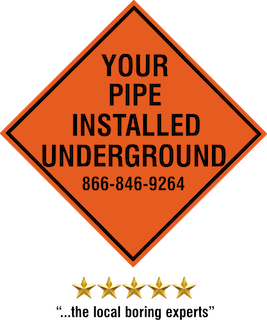Pipe Types
Carrier, carrier pipe, casing, channels, conduit, ducts, product pipe, sleeve and tunnels are all terms used to describe pipes used in utility construction.
The following terms are often used in underground utility construction industry:
Carrier Pipe:
The tube which carries the product being transported and which may go through casings at highway and railroad crossings. It may be made of steel, concrete, clay, glassfiber reinforced polyester, plastic, ductile iron, or other materials. On occasion it may be bored direct under the highways and railroads.
Casing Pipe:
A pipe installed as external protection to a Product Pipe or Carrier Pipe.
Conduit:
A broad term that can include pipe, casing, tunnels, ducts, or channels. The term is so broad that it should not be used as a technical term in boring or tunneling.
Duct:
In many instances, a term interchangeable with pipe. In the boring industry, it is usually used for small plastic or steel pipes that enclose wires or cables for electrical or communication usage.
Cased Bore:
A bore in which a pipe, usually a steel sleeve, is inserted simultaneously with the boring operation. Usually associated with Auger Boring.
Casing Pipe:
A pipe installed as external protection to a Product Pipe or Carrier Pipe.
Carrier Pipe:
The tube which carries the product being transported and which may go through casings at highway and railroad crossings. It may be made of steel, concrete, clay, glassfiber reinforced polyester, plastic, ductile iron, or other materials. On occasion it may be bored direct under the highways and railroads.
Wrapped Casing (Wrapped Pipe):
A coating on pipe for protection from corrosion, usually composed of asphalt and asphalt coated paper. Some coatings may contain plastic, fiberglass, coal tar, or other materials.
North Carolina Underground Construction Utility Pipes Types | HDPE Pipe
North Carolina Underground Construction Utility Pipes Types | HDPE Pipe
HDPE pipe also called poly or polyethylene pipe is ideal for many different underground utility applications including municipal, industrial, energy, geothermal and landfill. HDPE pipe is strong, durable, flexible and lightweight. When heat (butt) fused together, HDPE has a zero leak rate because the fusion process creates a monolithic HDPE system. HDPE pipe is also a more environmentally sustainable option because its non-toxic, corrosion and chemical resistant. HDPE has a long design life, and is ideal for trenchless installation methods because of its flexibility.
HDPE pipe meets or exceeds operating temperatures and pressures. HDPE pipe is an excellent insulator, with minimal heat transfer. Copper transfers heat 2,700 times more than HDPE. HDPE does not become brittle at 32 degrees Fahrenheit. HDPE does not leak because it is seamlessly fused. HDPE does not corrode.
We prefer using HDPE over other the alternatives in nearly every underground utility installation project we bore.
North Carolina Underground Construction Utility Pipes Types | PVC Pipe
North Carolina Underground Construction Utility Pipes Types | PVC Pipe
Regular PVC (polyvinyl chloride) is a common, strong but lightweight plastic used in underground construction. It is made softer and more flexible by the addition of plasticizers.Roughly half of the worlds polyvinyl chloride resin manufactured annually is used for producing pipes for municipal and industrial applications. In the water distribution market it accounts for 66% of the market in the US, and in sanitary sewer pipe applications, it accounts for 75%.
Applications for this technology cover every aspect of piping installations including both pressure and non-pressure situations in the water, sewer, electrical, industrial and telecommunications industries.
PVC has been used for over 50 years. Owner and contractor familiarity of the pipe is well established.
PVC is todays most widely utilized pipe material in the United States.
PVC has superior stiffness (modulus) compared to other plastic pipe, which limits long term deformation under soil load.
High tensile strength (ASTM D638) of the fused joint (up to 7,000 psi) allows for higher safe pulling stresses and consequently longer installation pull-in lengths.
PVC resists hydrocarbon permeation better than other thermoplastic pipe systems (AWWA Research Foundation).
Low wall thickness for given pressure requirement translates into highest flow per outer diameter (OD) dimension.
PVC is more resistant to water disinfectant induced oxidation than other thermoplastic pipe systems.
PVC material properties have low time dependencies the properties do not change over time no pull-in relaxation period for example.
North Carolina Underground Construction Utility Pipes Types | Steel Pipe
North Carolina Underground Construction Utility Pipes Types | Steel Pipe
Steel casing pipe protects one or many of various types of utilities such as water mains, gas pipes, electrical power cables, fiber optic cables, etc.
The utility lines that are run through the steel casing pipe are most commonly mounted and spaced within the steel casing pipe by using casing spacers that are made of various materials, including stainless steel or carbon steel and the more economical plastic versions.
Steel pipe is often required for casing underneath roads, highways and railroads particularly for wet utilities like water mains, sewer lines and oil and natural gas pipelines.
With our larger directional drilling rigs we can pull steel casing hundreds to a couple thousand feet.


